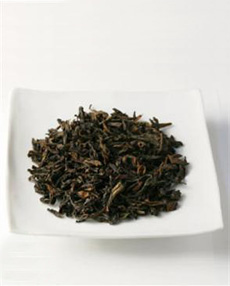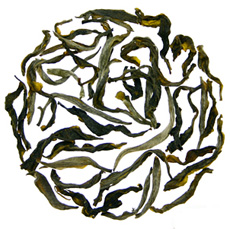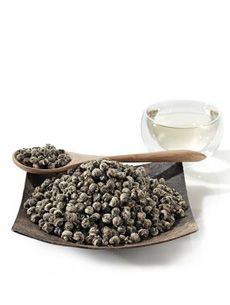This glossary is protected by copyright and cannot be reproduced in whole or part.
You are welcome to link to it.
PAN-FRIED
A Japan method where the tea is steamed then rolled in iron pans or woks over charcoal fires.
PEAK
The high point of the black tea tasting experience when, some moments after the liquor enters the mouth, its body, flavor, and astringency are fully revealed. Greens and oolongs do not peak but present themselves immediately.
PEARL
Some of the more delicate tea leaves—jasmine-scented tea and gunpowder tea are examples—are rolled into small pellets, or pearls. Reducing the surface area of the leaf helps to preserve the delicate flavors. When the tea is introduced to hot water, it unfurls into its normal size. See the photo above.
PEKOE
A small bud grows at the tip of each stem of the tea plant, curled over on itself, forming what the Chinese call pak-ho or pekoe. During the imperial harvest, only this bud and the leaf next to it are plucked (“two leaves and a bud”). The quality of the harvest is determined by the number of leaves next to the pekoe that are plucked. The more leaves in the mix, the lower the quality of the harvest.
PLAIN
A liquor that is clean but dull, lacking in desirable characteristics.
PI-LO-CHUN
A rare, organic tea acclaimed as one of the top 10 teas in China, pi-lo-chun is grown in the Dong Ting Mountains of China, south of the Yangtze River in Jiangsu Province. The beautiful topography—vast Taihu Lake and green mountains—are also home to apricot, plum and peach trees. The young tea plants grow in the shade of these fruit trees and absorb the delicate fruit fragrances. The harvested leaves are hand-rolled into downy spirals, a unique shape for a unique tea.
PLANTATION
See estate.
|
|

Pi-lo-chun from Teavana.com. |
PLUCKING
The process of harvesting the tea by cutting the flush from the growing tea shrub.
POINT
A bright and penetrating characteristic. A liquor is said to have point if it shows some desirable property—for example, briskness or fine fragrance.
POLYPHENOLS
The compounds present in tea that provide the astringency and pungent taste of tea, and also the antioxidant value. The water-extractable polyphenol content of green tea ranges from 30% to 40%; black tea has between 3% and 10%.
POUCHONG
A kind of scented Chinese or Taiwan tea, so-called from the Cantonese method of packing tea in small paper packets, each of which was supposed to be the product of one choice of tea plant.
POWDERY
Fine light dust, meaning a very fine light leaf particle.
|
|

Pouchong tea from TavalonTea.com. |
PRESENTATION TEA
See display tea.
|
PU-ERH or PU-ER or PU’ER or
DARK TEA
A special category of tea from Yunnan province, China and considered a medicinal tea in China. The base green tea for all forms of pu-erh is known as saiqing mao cha (sun-dried course tea). There are two types of pu-erh, shu pu-erh (ripened by pile-fermentation) and sheng pu-erh (raw, steamed and preserved without pile fermentation). With long-term use, pu-erh is said to reduce cholesterol, hangovers, and to improve dental hygiene. It also is the basis for “slimming tea” and “beauty tea.” The tea is usually compressed into shapes such as bricks, discs, birds’ nests or spinning tops. |
|

Organic and Fair Trade Certified pu-erh tea available from RishiTea.com. |
While most teas are consumed within a year of production, pu-erh can be kept for years for the aging process. Pu-er improves with age, owing to the specific type of oxidation that affects the tannins. The tea is often steeped for long periods of time or even boiled (Tibetans boil it overnight). The flavors and aromas are earthy and smooth. Pu-erh teas are available in black, brick green, oolong, and white. Pu-er is produced in a steaming process that creates a non-enzymatic fermentation, different from the fermentation of black teas. Before rolling, the leaves undergo a specific type of roasting in iron pans, which kills most of their enzymes. The pans are heated to 280°C to 320°C, the leaves are added and then covered with straw. The straw stops the steam from escaping and allows the leaves to be steam-cooked. A first rolling is carried out, then a sweating that lasts about 24 hours and can be repeated several times to enhance the aroma. Pu-erh tea is one of the costliest teas.
PUNGENT
Astringent with a good combination of briskness, brightness and strength.
Continue To Page 12: Tea Terms Beginning With Q & R
Go To The Alphabet Index Above
Lifestyle Direct, Inc. All rights reserved. Images are the copyright of their respective owners.







